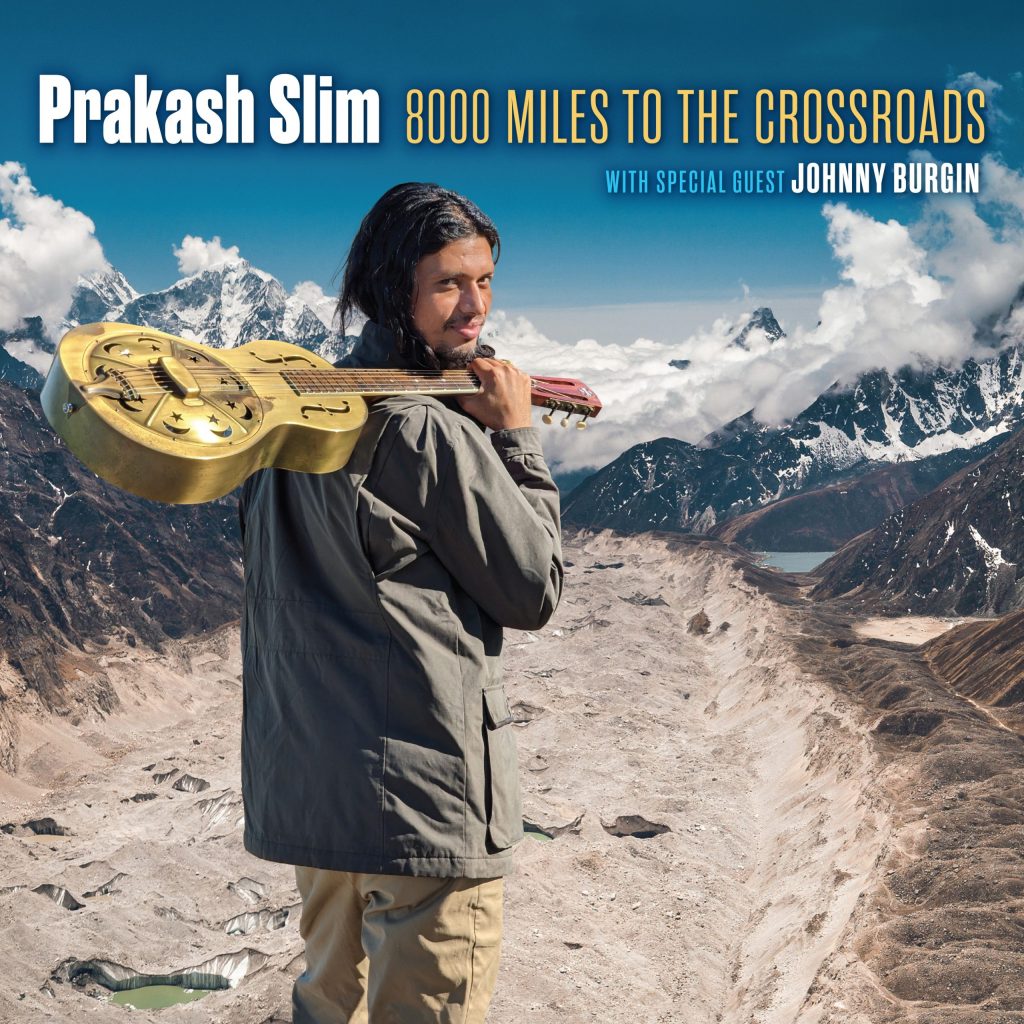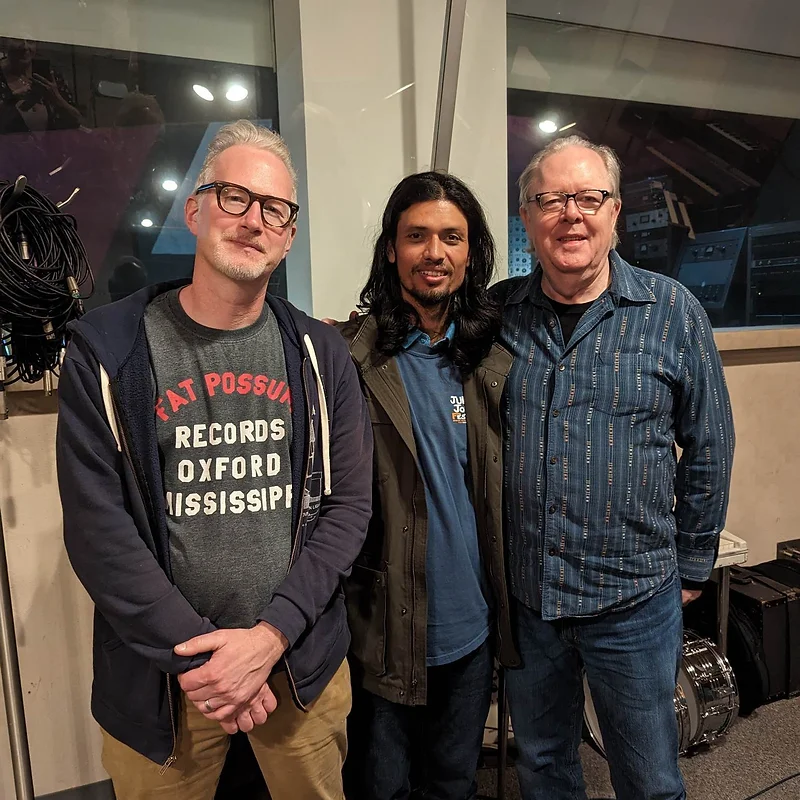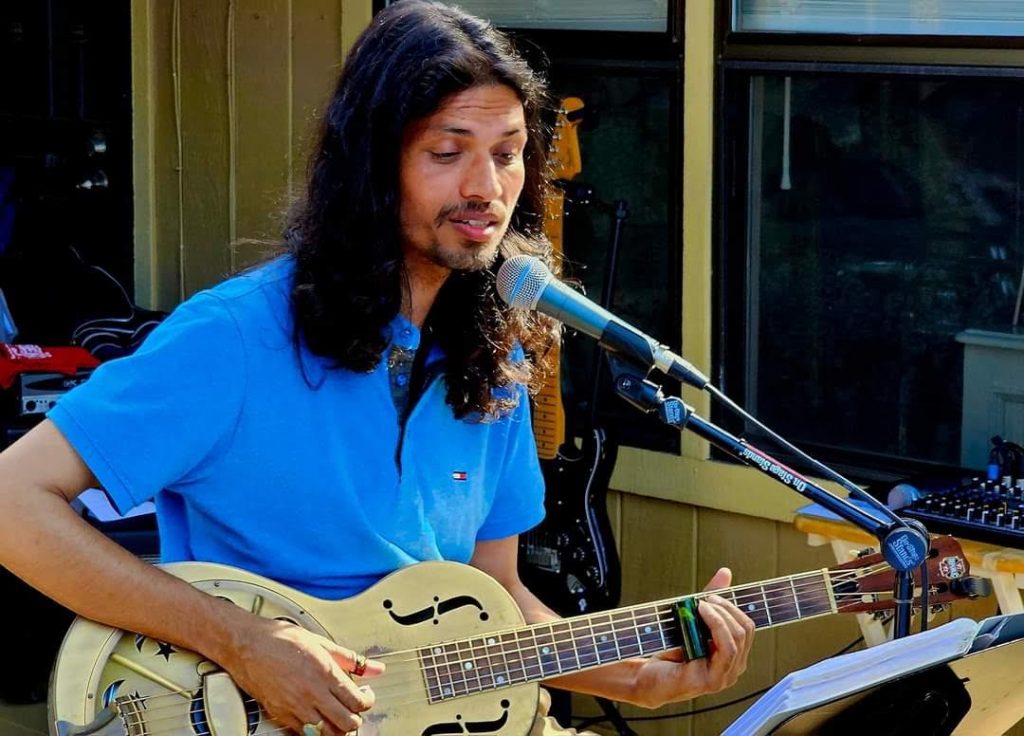8000 Miles to the Crossroads carves out a space for Prakash Slim’s voice in the global blues scene, inviting everyone to join him on this remarkable journey both literal and metaphorical.
As producer Michael Freeman writes in the liner notes, “When I found out that Prakash was going to be in Clarksdale for the Juke Joint Festival and so close to Memphis, I got in touch with him and offered to record an album for him at Sam Phillips Recording before he returned to the west coast.”

It’s truly fascinating to see how a singer-songwriter/guitarist hailing from a remote village in Nepal forges a connection to the iconic Sun Records legacy by recording at Sam Phillips Recording in Memphis, but should come as no surprise. Opening the album with Mississippi Fred McDowell’s “Kokomo Blues,” Prakash’s vocal style and driving rhythm naturally overlap with a classic country sound. Often credited as the Father of Rock and Roll due to his role as a producer and founder of Sun Records, Sam Phillips himself was venerated for his ability to bridge the gap between genres. He recorded and captured the raw energy of blues artists like B.B. King and Howlin’ Wolf, while also fostering rockabilly pioneer Carl Perkins and country legend Johnny Cash.
The choice to record at Sam Phillips highlights the rich interplay between country and blues, respective genres that Phillips championed and a fusion which Prakash has long perfected — a cross-cultural exchange that enriches the blues genre and reminds us of the power of music to transcend geographical and cultural boundaries. “It was a great experience recording at legendary Sam Phillips where Elvis Presley, Johnny Cash, and many other legends would record,” Prakash tells me. “Being inside the studio and to know about their history is like history making itself. I got an opportunity to record at a historic studio and with the blues greats, so I think it played a great role in determining the outcome of this album.”

“Old Man Blues” is a standout track, melodic with percussive elements and smooth transitions between notes. By staying conscious of muscle memory, purity, depth, and lyrical content of the song, he keeps his resonator playing stimulating and engaging. His vision for the song encompasses not just the musical composition but also the emotional narrative he wants to convey. This kind of intentionality can transform a piece into a powerful storytelling experience, allowing audiences to connect deeply with the themes he explores.
“I have seen many old people suffering from the pain in this mean world,” Prakash elaborates. “I have some memories with my grandmother. She lived with my uncle and she had everything she wanted. I used to spend a lot of time with her. She would share stories and her life experiences with me. When she felt pain in her leg, I would massage. I couldn’t help her a lot, but if I had money I would have bought new clothes for her. She lived ninety-four years and took her last breath on my lap.
“Many mothers, fathers, grandmas and grandpas get left in the street by their family or society because of their old age. They do not have shelter and they have to spend the night under the sky and on the cold ground. They can’t work, their body parts do not work because of their age, but no one asks them how they are. Hands get rugged and knees get bent. Their eyes are tired from seeing if somebody is coming to see them. They still remember and share all the things with their children and families, but no one knows their pain.”
Special guest Rockin’ Johnny Burgin had been playing gigs with Prakash before he came into the studio, bringing his traditional blues touch, tone, and technique to “Kokomo Blues,” “Everyday Blues In My Heart,” “Talking Nepal Blues,” and last but not least, the thumping title track. “Johnny presented wonderful electric guitar work; his presence on this project is invaluable. We were connected through Facebook about six years ago. We are good friends and he helped me a lot for my American tour. We played together during our tour, and I stayed with him and his wife Stephanie Tice at their home in Virginia. They really are great people.”
Fully based on Prakash’s life story, original track “Talking Nepal Blues” lives up to its name in its conversational phrasing. “I was finalizing the songs with Johnny Burgin, his wife Stephanie, and my US sponsor Lance Bowman before our tour. Johnny asked that we do Prakash’s real story with John Lee Hooker guitar style. I also love John Lee Hooker style, and we decided to do this tune. It’s very important to me because it speaks about moments from a tragic childhood – a crazy young blues guy who didn’t have money to buy a guitar and had to trade his gifted bicycle for a guitar.”
He was born in a field during Nepal’s monsoon season in the small village of Lamatar located in Lalitpur district. The village saw its first electric bulb in 1983 and its first motor car in 1995. To give context, Prakash was born in 1980. His father passed away at the age of 29, leaving his mother with three children to raise, one elder brother, a sister, and Prakash. What little food they had was earned by their mother, who worked in their neighbors’ fields. Every year, he waited for their main festival to be celebrated, when his uncle would give him a pair of new clothes. He went to a public school where instead of desks and benches, they had mats made of straw.
When asked what his ambition was when young, Prakash Slim replied, “Ambition was a privilege for rich kids back then. The only ambition I had was sustaining life.” Growing up under challenging circumstances with limited resources would have tested anyone’s spirit, and his story paints a vivid picture of resilience and resourcefulness.
Prakash’s talent for weaving intricate fingerpicking patterns and rhythmic strumming with the resonator remains the most striking aspect of his musical style, and his commitment to honing his craft ensures that his artistry advances. He enthuses,” I feel that my sound has evolved over time and since my last project. It’s been two and a half years since my first cd. I have been touring and getting experiences from various places and with different people. I have tried to improve my work from the suggestions, advice, and comments I get from blues fans, friends, and community.”
He keeps the heart of country blues beating, closing the album by honoring an essential entry in the Charley Patton canon: “Hammer Blues.”
He adds, “This new album has become possible with the help of these awesome people. Blues master Johnny captivated us with his magical guitar work, Henry D. Jones contributed to the writing process, and our recording engineer was Grammy-nominated Scott Bomar. Blaise Barton handled mixing at his Grammy-winning Joyride studio, with Grammy-winning audio engineer Paul Blakemore mastering. Cover and inside photos were taken by Lance Bowman and Stephanie Tice. Al Brandtner was our graphic designer. Grammy and BMA-winning Michael Freeman produced this album and played drums. So, this is a full blues package with traditional style. It is available on Blue Point Records (Chicago) and also available on Spotify, Tidal, Apple and Amazon. Please enjoy the blues.”


